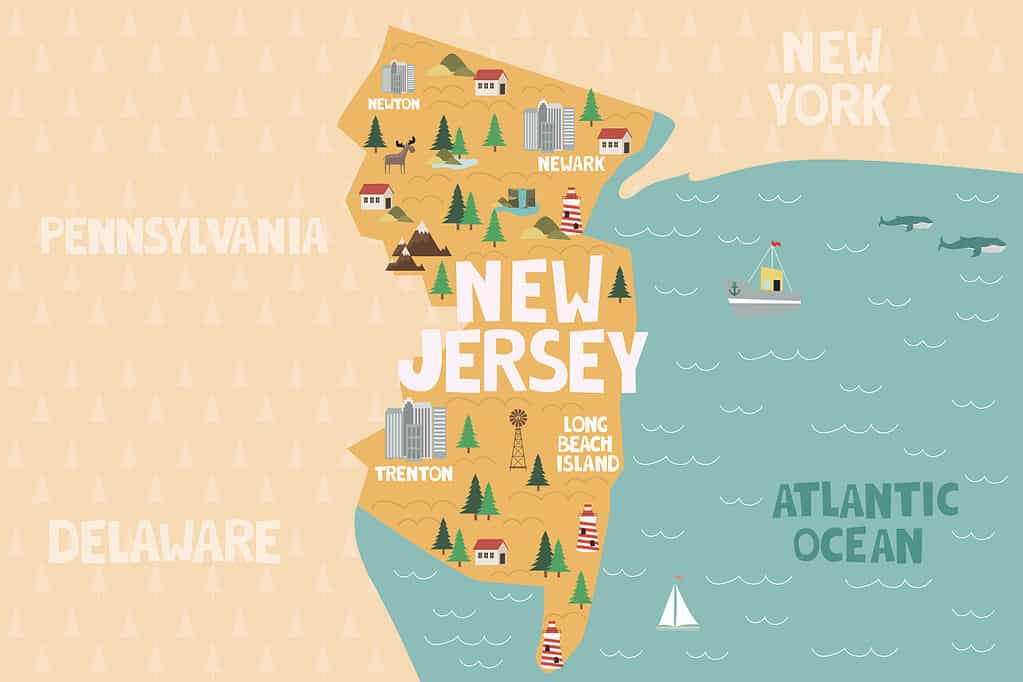
New Jersey is home to numerous snakes but only one is venomous.
©iStock.com/BonneChance
You might not realize it, but there are actually tons of snakes in New Jersey if you know where to find them. In fact, many even live in cities and other urban areas. Most of the snakes in New Jersey are completely harmless to humans, but there are a few rare venomous snakes in the state, including just one type of rattlesnake. Let’s take a closer look at New Jersey’s only rattlesnake species and see where it is found, what it looks like, and why it is so rare in the Garden State.
Timber Rattlesnake
| Timber Rattlesnake | |
|---|---|
| Range | Small, isolated populations in northern, central, and southern New Jersey |
| Length | 36-72 inches |
Although it once lived all across the state, today the timber rattlesnake is rare in New Jersey. It is most common in the northern and central regions of the state, but there are also small, isolated populations in the southern region as well. Timber rattlesnakes are the most endangered species in New Jersey and are tragically persecuted by humans who both kill and collect them illegally. Because of this, timber rattlesnakes in New Jersey are protected by state laws. People can help conserve the timber rattlesnake by reducing habitat destruction and human persecution.
In addition to human threats, timber rattlesnakes in New Jersey also suffer from human encroachment, habitat destruction, and fungal disease. These rattlesnakes are shy and reclusive animals that prefer to avoid contact with humans, living in rugged and remote areas throughout the state. In New Jersey, they primarily live in forests and wooded areas with rocky outcroppings. They prefer areas with thick brush and dense trees where there is a lot of cover, as well as sunny rocky areas for basking. This helps them to regulate their body temperature and stay out of sight from any lurking and hungry predators. Some of the timber rattlesnake’s predators include other snakes, birds of prey, and mammals.
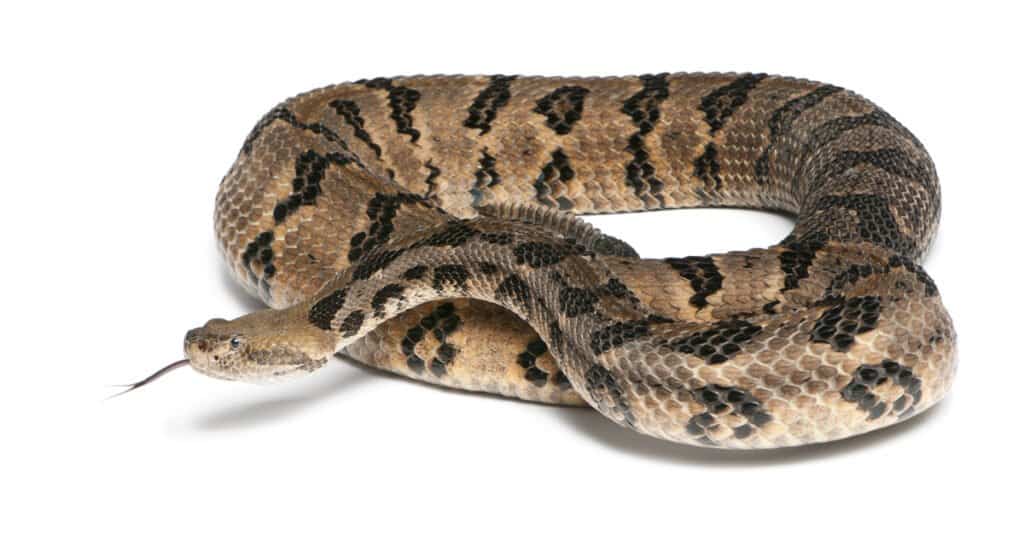
Timber Rattlesnake can grow to be up to six feet long, with black tails and a large rattle on the end to warn off predators.
©Eric Isselee/Shutterstock.com
Appearance
There are two primary colorations of timber rattlesnakes in New Jersey: brown or yellow with a light-colored head, and gray or black with a dark-colored head. Both color phases have zigzag- or diamond-shaped black bands on their backs. These snakes can grow to be up to six feet long, with black tails and a large rattle on the end to warn off predators. Their rattles are made of keratin that builds up into segments each time the snake sheds. When the snake feels threatened, it will vibrate the end of its tail, causing these interlocking rings to rattle and make a loud buzzing sound.
Timber rattlesnakes are large pit vipers with broad, triangular-shaped heads and heat-sensing pits on their faces. They use their pit organs to locate prey and then lie in wait until the animal gets close enough to catch. The timber rattlesnakes living in New Jersey eat small mammals such as mice and rats, as well as birds and some reptiles.
Venom
The timber rattlesnake is a highly venomous snake that can be very dangerous to humans. Its neurotoxic venom can cause serious health problems, including tissue damage, organ failure, paralysis, and even death.
However, these snakes are also very shy and reclusive, and will only attack if they feel threatened. Even then a timber rattlesnake may choose to “dry bite”, which means that it does not inject any venom into its bite. Timber rattlesnakes are not aggressive and would rather hide, flee, or rattle loudly as a warning. Striking only occurs as a last resort if the snake is harassed or cornered.
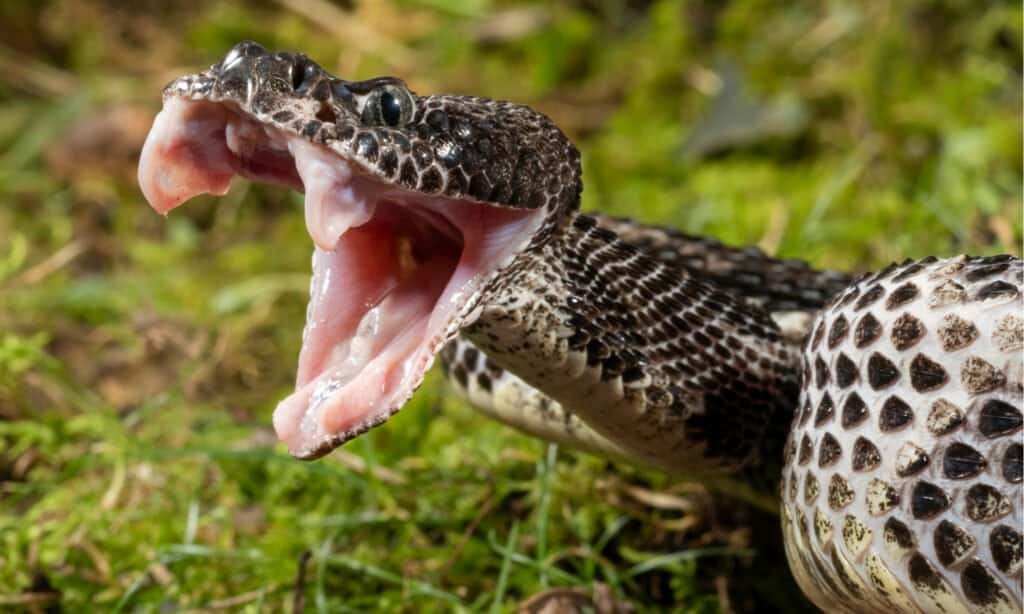
The timber rattlesnake is a highly venomous snake that can be very dangerous to humans.
©Joe McDonald/Shutterstock.com
What To Do If You See A Timber Rattlesnake In New Jersey
If you encounter a rattlesnake or hear a rattling sound, slowly back away and give the snake at least 10-15 feet of space. Do not attempt to capture or kill it. Timber rattlesnakes are venomous, but they are usually calm. If they cannot hide, they will rattle a loud warning to try to scare off any threats. Most timber rattlesnake bites happen only because the snake was either purposefully harassed or someone accidentally stepped on it! If by chance you are bitten by a rattlesnake, call 911 and seek medical attention immediately.
Helping Timber Rattlesnakes In New Jersey
Because of their rarity, the Division of Fish & Wildlife in New Jersey asks that if you see a timber rattlesnake in the state, you stay at least 15 feet away from it. If you can do so safely, please take a picture of the snake. In addition, please submit a Rare Wildlife Sighting Report Form to help researchers continue to track and help these endangered snakes.

©Scott Delony/Shutterstock.com
Snakes Commonly Confused With Rattlesnakes In New Jersey
While there is just one type of rattlesnake living in New Jersey and it is quite rare, there are several other harmless snakes that cause quite a scare because they are often mistaken for a timber rattlesnake. Here are just a few examples:
Northern Pine Snake
| Northern Pine Snake | |
|---|---|
| Range | Pine Barrens of New Jersey |
| Length | 48-100 inches |
Another threatened species in New Jersey, the northern pine snake lives in the Pine Barrens of the state. It burrows underground in sandy habitats, where it shelters from the elements and lays its eggs. It is a fairly large snake with a gray, white, or cream-colored body and dark blotches along its back. Although this snake is harmless to humans, when it feels threatened it will defend itself with passion, hissing and delivering painful bites if you try to pick it up.
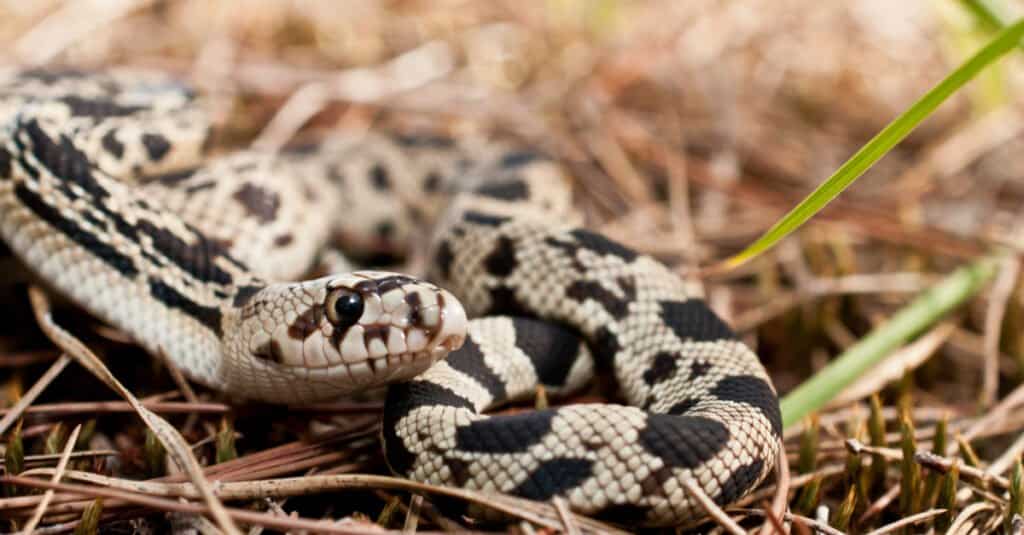
The spots on a pine snake are generally darker towards the head and lighter towards the tail.
©Jay Ondreicka/Shutterstock.com
Black Rat Snake
| Black Rat Snake | |
|---|---|
| Range | All of New Jersey |
| Length | 34-101 inches |
The largest snake in New Jersey is the black rat snake, measuring 34-101 inches long. These snakes are fairly common throughout the state, usually in suburban or rural areas. Adult snakes are black with white chins and throats, and either a pale yellow or white belly. Juvenile black rat snakes, however, are very commonly mistaken for timber rattlesnakes, since they are gray with dark blotches. Black rat snakes are excellent climbers and are often seen high up in rock crevices or resting in trees.

Large adult Eastern black rat snake in defensive coiled posture on road. The snake has a shiny black body with a checkerboard belly.
©Mike Wilhelm/Shutterstock.com
Eastern Hognose Snake
| Eastern Hognose SnakeRangeAll of New JerseyLength20-45 1/2 inches long |
|---|
Although they are rarely encountered in most parts of New Jersey, eastern hognose snakes live throughout the state and commonly cause fear in humans because of their appearance and behavior. However, these snakes are completely harmless and only act threateningly. Eastern hognose snakes are usually smaller than timber rattlesnakes, growing between 20-45 ½ inches long. These snakes come in a wide variety of different colors and patterns, and some snakes may have patterns similar to a timber rattlesnake. In addition, when eastern hognose snakes feel threatened, they stretch their necks out wide like a cobra and hiss loudly, often pretending to strike in order to scare away the threat.

When eastern hognose snakes feel threatened, they stretch their necks out wide like a cobra and hiss loudly.
©IHX/Shutterstock.com
Other Animals Found In New Jersey
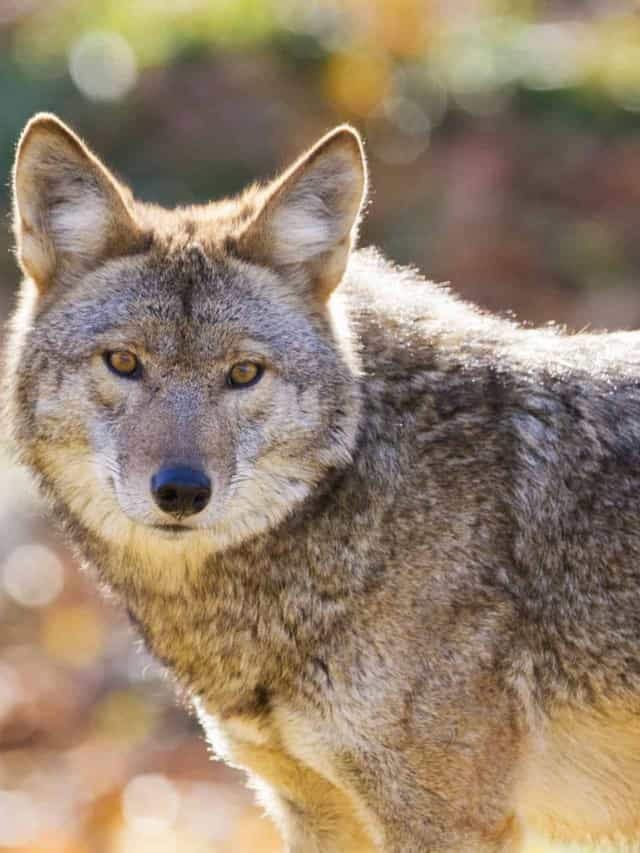
Coyotes are generally nocturnal and not usually seen during the day.
©Mircea Costina/Shutterstock.com
The coyote is a species of canine that is endemic to North America. Closely related to the wolf but smaller in size, with an average weight of 15 to 46 pounds, they have similar characteristics – they are nocturnal, preferring to sleep during the day and communicate by howling, although their howls are much more high pitched and as they have less territory than a wolf, their howls don’t travel quite as far. Coyote attacks against humans are rare but they can be dangerous to pets and children.
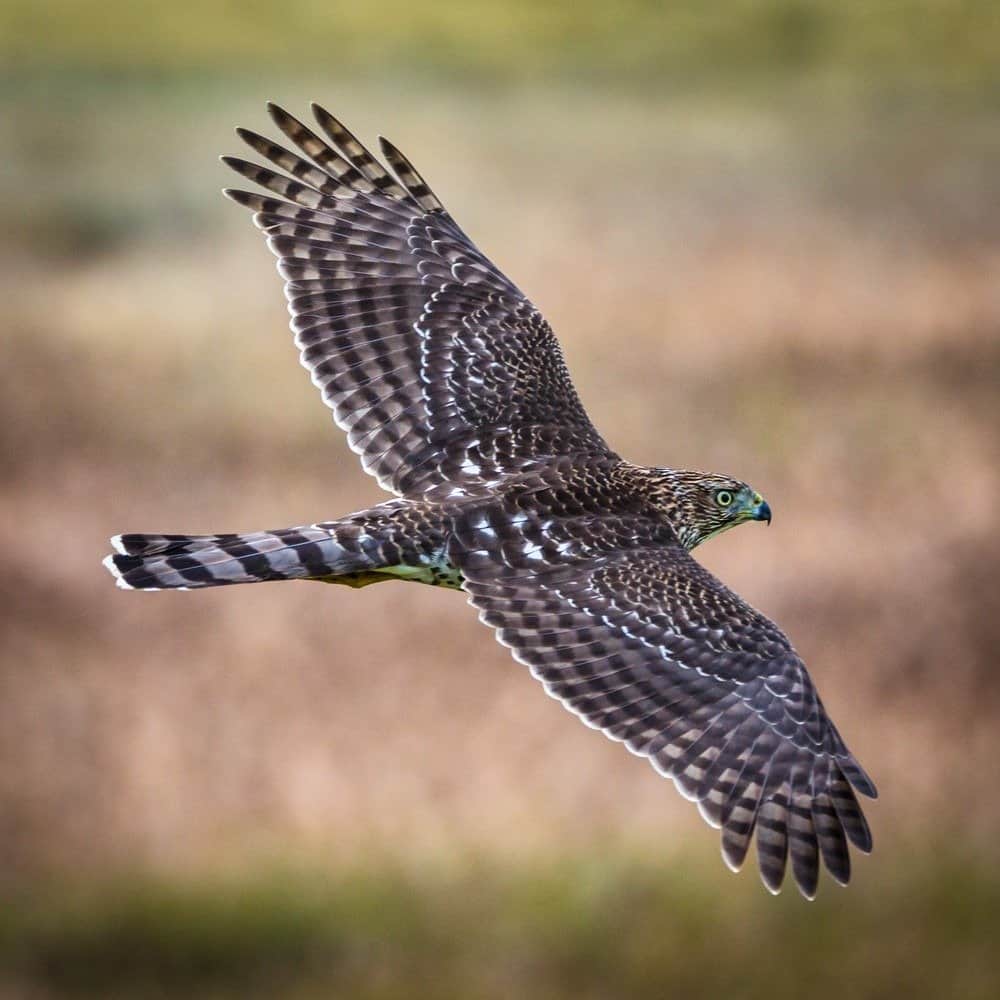
Cooper’s Hawk flying
©michaelschober/Shutterstock.com
New Jersey is home to 8 species of hawks and one of those is Cooper’s hawk, also known as the chicken hawk, which is a medium-sized hawk with broad, rounded wings and a very long tail. It is similar in size to a crow, reaching lengths of between 14 to 15.3 inches and weighing anywhere from 7.8 to 14.5 ounces. The colors of adults are bluish-gray on top and pale reddish-white undercoats and they are generally found in wooded areas. These hawks are early birds, preferring to hunt earlier in the day, and sightings of them in the evening are rare.
The photo featured at the top of this post is © Joe McDonald/Shutterstock.com
Discover the "Monster" Snake 5X Bigger than an Anaconda
Every day A-Z Animals sends out some of the most incredible facts in the world from our free newsletter. Want to discover the 10 most beautiful snakes in the world, a "snake island" where you're never more than 3 feet from danger, or a "monster" snake 5X larger than an anaconda? Then sign up right now and you'll start receiving our daily newsletter absolutely free.
Sources
- Wildlife Conservation Society / Paré, J.A.;Conley, K.J.;Boyer, D.M,;Schantz, K.A., Available here: https://programs.wcs.org/databases/doi/ctl/view/mid/33065/pubid/PUB15659.aspx
- NJ.gov, Available here: https://www.nj.gov/dep/fgw/ensp/pdf/snake_broch.pdf
- New Jersey Fish and Wildlife, Available here: https://dep.nj.gov/njfw/wildlife/endangered-and-threatened-species/
- New Jersey Fish and Wildlife, Available here: https://dep.nj.gov/njfw/conservation/timber-rattlesnake-conservation/
FAQs (Frequently Asked Questions)
What is the one type of rattlesnake in New Jersey?
Although it once lived all across the state, today the timber rattlesnake is rare in New Jersey. It is most common in the northern and central regions of the state, but there are also small, isolated populations in the southern region as well. Timber rattlesnakes are the most endangered species in New Jersey and are tragically persecuted by humans who both kill and collect them illegally.
What snakes are mistaken for a timber rattlesnake?
The Eastern Hognose, Black Rat and Northern Pine snakes are often confused for Timber Rattlesnakes.
Thank you for reading! Have some feedback for us? Contact the AZ Animals editorial team.






